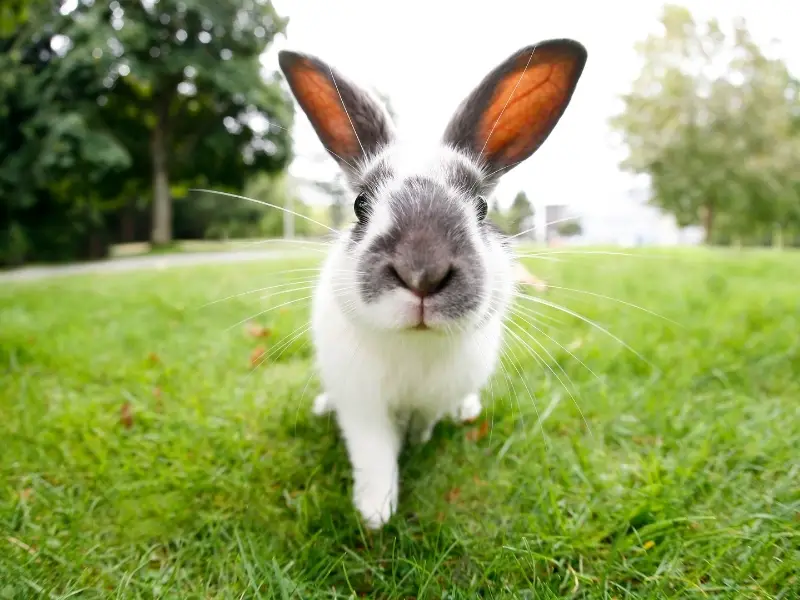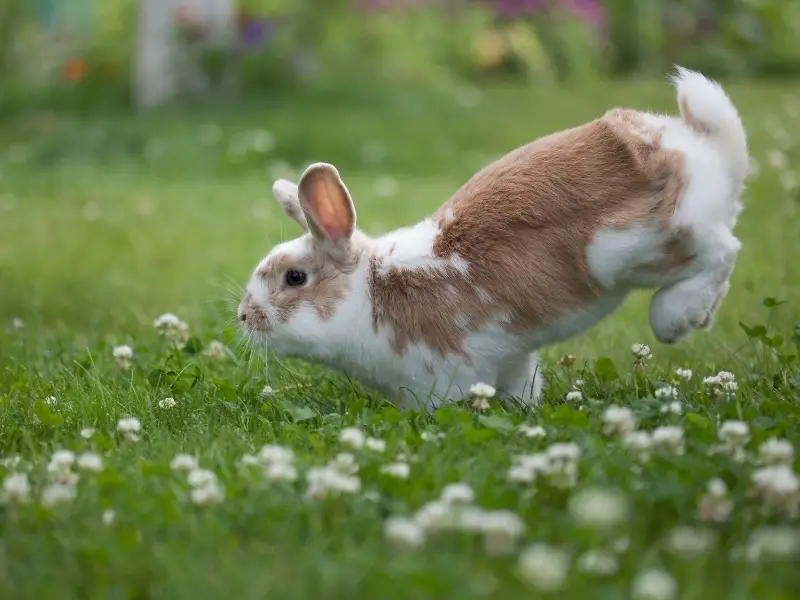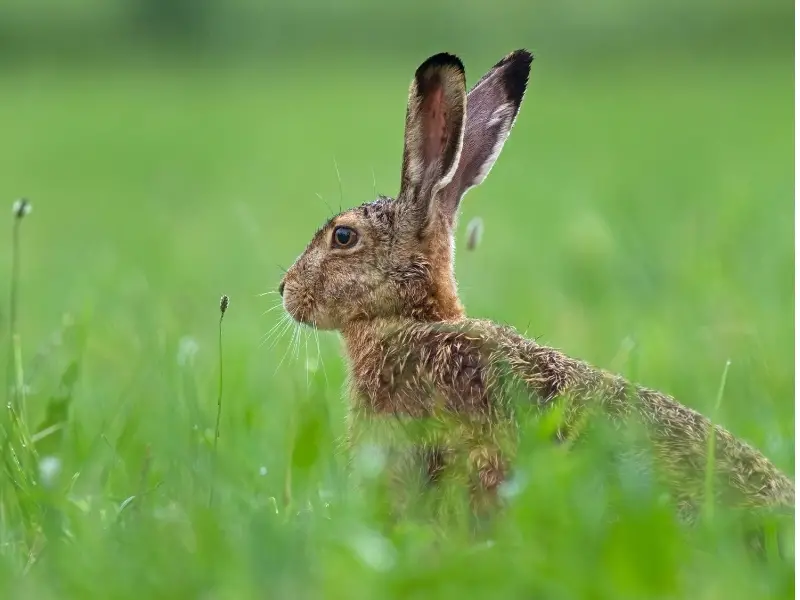You come across a small young animal with long-ish ears and a hairless body in your yard, and wonder if the baby is a bunny, a rabbit, or a hare. That gets you thinking, “What exactly are the differences between a hare, rabbit, and bunny?”
The terms rabbit, bunny, and hare are often used interchangeably. Bunny is often a cutesy term for a rabbit or can be used to describe a baby rabbit. A rabbit and a hare belong to the same Leporidae family but they are different species. In short, a rabbit is smaller and more sociable than a hare.
To make matters even more confusing, a cottontail rabbit shares more commonalities with a hare than a rabbit and a jackrabbit is a kind of hare. Rockhares, on the other hand, are rabbits.
Want to untangle the confusion? Then keep on reading as we share what the differences are between a bunny vs rabbit vs hare.
Are Bunnies and Rabbits and Hares the Same Thing?
What exactly is a bunny? What about a hare and a rabbit?
What Is a Bunny?
However, it is commonly used to refer to baby rabbits, which are actually called kittens (yes, the same as what you’d call baby cats). And since a hare looks similar to a rabbit, the word bunny can be used to refer to a hare as well.
Technically, a bunny is a colloquial term that is used to refer to rabbits, no matter their age.
So, scientifically, there is no such thing as a bunny. There are only rabbits (and their offspring called kittens) and hares (and their offspring, called leverets).
What Is a Rabbit?
A rabbit is a mammal that belongs to the Leporidae taxonomic family. There are 49 rabbit breeds according to the American Rabbit Breeders Association (ARBA).
Typically, a rabbit is fluffy, has long ears, whiskers, and a short tail. Adult rabbits can grow to be as big as a cat at 20 inches and weigh 10 pounds; however, some breeds, like the checkered breed and giant papillon, can grow much bigger.
Pygmy or small rabbits only grow to be around 8 inches and they generally weigh less than a pound up or up to around 3 pounds.
The bone structure of a rabbit is flexible, which helps them navigate in their underground tunnels and burrows.
In the wild, rabbits generally live for a year or two, while domesticated rabbits can live between 8 and 12 years.
Some popular types of rabbit breeds include the mini lop, Rex rabbit, Lionhead rabbit, Angora rabbit, American fuzzy lop, and the Palomino rabbit.
What Is a Hare?
A hare also belongs to the Leporidae family and the Lepus genus. It is part of the Lagomorpha order of mammals (the same as what rabbits and pikas belong to). Hares have longer and stronger hind legs.
They also have longer ears than their rabbit cousins. Their ears also have black markings and their tails are short but longer than a rabbit’s.
The body of a hare can grow to 16 to 28 inches, with feet as big as 5.9 inches and ears up to almost 8 inches long.
A hare’s bone structure is also different. They also have kinetic skulls to help them absorb more shock while running at fast speeds.
Some hare breeds include the snowshoe hare, Cape hare, arctic hare, Alaskan hare, mountain hare, desert hare, and scrub hare. As mentioned earlier, a jackrabbit, like the white-tailed jackrabbit or black-tailed jackrabbit, is also a hare.
Bunny Vs Rabbit Vs Hare – Comparison

Let’s dive into the differences and similarities between a rabbit and a hare (remember, a bunny is used to refer to both these animals).
Habitat and Danger Response
Hares are surface dwellers and usually live in wild arid areas. For shelter, they prefer shallow holes or bushes.
Rabbits, on the other hand, dig a lot and find shelter in a warren, or an underground network of interconnecting burrows. A warren can be as big as 150 feet long and 10 feet deep.
With regard to their danger response, rabbits and hares respond differently.
Rabbits tend to hide underground, while hares run away. They are professional runners and can run up to nearly 40 body lengths in a second.
Behavior
Rabbits are social animals and they live in their family warrens, which have a complicated social hierarchy.
Their colony survival depends on the rabbits working together. They are also territorial animals in the wild and will protect their warren from unrelated rabbits that try to gain entry.
Hares are not social as they live isolated from each other. The only time a hare associate with another hare is when it is mating season.
Gestation
The gestation period differs for rabbits and hares, even though it is relatively short for both mammals.
A rabbit’s gestation period is typically between 31 and 33 days. When a female rabbit, or a doe, gives birth, it is called kindling.
The average litter size is 5 kittens but does can give birth to as many as 12 kittens, or kits. Rabbits can have 3 or 4 litter per breeding season.
Yes, rabbits are prolific breeders, but in the wild, only 15% of their kittens live past their first year.
Kittens are born blind with their eyes closed and deaf with their ears closed. Baby rabbits are hairless and are completely dependent on their mother for about 8 weeks.
For a hare, their gestation period is between 36 to 37 days. The average litter size for hares is 2 to 4 leverets (or baby hares), and a female hare, called a jill, can give birth to 3 litter a year.
A leveret is born precocial, or fully aware, with their ears and eyes open, and they are also furred. They need little protection and care from adult hares, but the jills nurse the leverets for up to 4 weeks from birth.
Fur
Both hares and rabbits shed their fur coats when the seasons change. In winter, they grow a thick coat to help keep them warm, while in summer, they have tinner coats for the warmer weather.
A rabbit’s coat will stay the same color, but their coat for winter may be lighter or grayer.
A hare’s coat changes more drastically from winter to summer. For example, the snowshoe hare has a white camouflage coat in winter while it is brown during the summer months.
Food
Both hares and rabbits eat plant-based diets. Rabbits prefer to eat softer vegetation, such as leafy greens, veggies, and grass. Hares eat rougher vegetation, like twigs, bark, roots, and buds.
With regard to water, adult hares and rabbits can drink 5 fluid ounces per day.
Care
Hares are not domestic animals and should not be kept as pets. The Belgian hare is, in fact, a domesticated rabbit bred to look like a hare.
To care for your pet rabbit, ensure your house is bunny-proof. Your rabbit should live indoors but should not stay caged all day. It needs exercise.
Feed your rabbit a balanced diet of hay, veggies, fruits, the occasional treat, and water.
Rabbit, Bunny, and Hare Terminology Usage

When to Use Rabbit?
Use rabbit to refer to an adult rabbit, either a domesticated or wild one. You can also use rabbit when referring to rabbit meat, which is a common protein source in China, South Korea, Egypt, Africa, and some Mediterranean countries.
When to Use Bunny?
The term bunny is most commonly part of a child’s vernacular, or language. Kids use the bunny to refer to both rabbits and baby rabbits.
Bunny can also be used to refer to a young girl as a term of endearment.
Lastly, there’s the Easter Bunny. Not that bunnies or rabbits actually lay eggs, but during Lent, Catholics weren’t allowed to eat eggs.
Rabbits and eggs are seen as a symbol of fertility or new life. Somehow, eggs became part of the Easter celebrations, as the Easter Bunny lays, decorates, and hides chocolate eggs for children to find.
When to Use Hare?
Use the word hare to refer to animals that look like rabbits but are larger in size and behave differently as they are non-social animals except during mating season.
Interestingly, there are also various idioms that use the word hare. Examples of four hare idioms and their meanings:
- as mad as a March hare > you are eccentric or crazy, or angry
- first catch your hare > get something first and then decide what to do with it
- if you run after two hares, you will catch neither > doing two things at once, or multitasking, results in failure
- run with the hare and hunt with the hounds > if there is conflict, you can’t support both sides
Conclusion
A bunny, rabbit, and hare are not the same animal, even though rabbits and hares come from the same family and look somewhat similar.
Key takeaways from the bunny vs rabbit vs hare comparison are:
- Bunny is a non-scientific term. Children mostly use this term to refer to rabbits and hares when they learn about animal names.
- A rabbit can be a wild or domesticated animal. They are social creatures and generally smaller than a hare.
- A hare is a wild animal, living in isolation until it is time to mate.
- Hares are larger than rabbits.
- A baby rabbit is a kitten or a kit (or colloquially a bunny), while a baby hare is a leveret.
What difference between a bunny, rabbit, and hare did you find most interesting to learn about? Please share with us in the comments section below.

